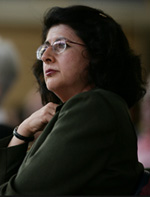Parlez-Vous Another Language?
 If you want to learn the French language, Dr. Mana Derakhshani can teach you. She’ll teach you to read it, write it, speak it, and understand it.
If you want to learn the French language, Dr. Mana Derakhshani can teach you. She’ll teach you to read it, write it, speak it, and understand it.
But she won’t stop there.
“Colleges ought to open windows for students and say, ‘hey, this is how life is in other parts of the world; this is how they do things,’ ” explains Derakhshani, associate professor of modern languages at Saint Mary’s. “As a foreign language professor, I try to also reverse that gaze and help students see themselves as people from other nations do and ask, ‘why do they perceive us that way?’ It’s important to have more than one cultural perspective, and you begin to understand a culture by learning its language. It’s also essential for citizens of the 21st century to acquire intercultural competence, the ability to interact effectively within different cultural frameworks.”
Derakhshani knows first-hand what it’s like to navigate many cultures. Born in Tehran, Iran, she moved to Morocco when she was two and lived there for 15 years. She spoke Persian at home and lived according to her Iranian culture. At school, her classes were taught in French (Morocco’s language of education at that time) and she took English as a foreign language starting in sixth grade.
She earned her bachelor’s, master’s, and doctoral degrees at the University of Utah, but spent her first year in the United States perfecting her English at the School of Mines in Rapid City, South Dakota. “Of all the transitions in my life, that’s the one I remember most,” says Derakhshani. “Not because school was difficult, but because I initially had trouble with friendships and dating. It’s done much differently in America. I grew up in a culture where we would all go out it groups, but there was no one-on-one dating, so the whole concept was new and different, and problematic at first.”
Derakhshani’s ability to translate that real-world experience into classroom teaching makes her a favorite with students. Beyond papers and projects are conversations about cultural proximics (how close you stand to someone when you’re speaking with them). Students also explore how simple behaviors like personal introductions can make or break a business meeting.
“No culture sees the world through clear glasses. They all have a color,” says Derakhshani. “Those who understand that will be more successful, and will help make this interconnected, interdependent world a better place.”

